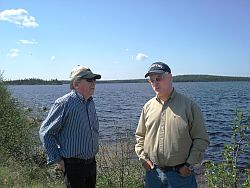 Three First Nation communities in northeastern Ontario are looking forward to a production decision by Detour Gold.
Three First Nation communities in northeastern Ontario are looking forward to a production decision by Detour Gold.
The former Placer Dome property, 190 kilometres northeast of Cochrane, produced 1.8 million ounces of gold between 1983 and 1999. Since then, higher prices and an ambitious drilling program have increased reserves to 8.8 million ounces, making the Detour Lake project the largest undeveloped gold reserve in Canada.
Toronto-based Detour Gold began meeting with the Moose Cree, Taykwa Tagamou and Wahgoshig First Nations in 2007. Memoranda of understanding have been signed with Moose Cree and Taykwa Tagamou and a deal with Wahgoshig is in the works. More detailed Impact Benefit Agreements are due to be negotiated in 2010 as the company completes a feasibility study and moves forward with permitting.
If all goes as planned, Detour Gold hopes to start construction before the end of 2010 and begin pouring gold by 2012 or 2013.
All three First Nation communities had experience negotiating deals with other companies and voiced support for the project provided the company respects their treaty rights, mitigates any impacts on the environment and offers training, employment and business opportunities, said Derek Teevan, Detour Gold's vice-president of Aboriginal and government affairs.
E3 Toolkit
The company used the Prospectors and Developers Association of Canada's e3 toolkit as a template for the engagement process, but made sure to ask its First Nation partners how they preferred to be engaged. Two of the communities delegated the consultation process to small negotiating committees. The third community, Taykwa Tagamou, asked Detour Gold to conduct negotiations through a band-affiliated resource company.Teevan sees the engagement process as both a requirement and an expression of good will.
"I think it's the right thing to do. We're legally obliged to consult and accommodate. How we do that is up to us, but it's in our best interest to work co-operatively with First Nation communities and other communities. The estimated life of the mine is 14 or 15 years, so we want to have a long-term relationship and recruit employees from the area. We also want to respect the environment, and hiring Northerners and First Nation people is the best way to do that."
Building trust requires a commitment to being honest and straight-forward, said Teevan. "Try for some small, collective wins, an interim measure, an activity to help build the relationship," he advises.
Patience also helps, he said.
"You have to acknowledge that they have a lot of other things they're working on and this is just one of them."
Teevan, who worked in a similar role with De Beers Canada negotiating an impact benefit agreement with the Attawapiskat First Nation, also recommends getting to know the community away from the negotiating table.
Unstructured time
"You need to book unstructured time," he said. "That's when you learn the most. Spend time with people around the kitchen table. That's when you learn about the community, its needs, interests, fears and opportunities. You can get a sense of how important things are and how they rank. You meet the unelected leaders of the community, the elders, educators and youth."A lot of the time, the youth are very progressive. They have a lot of energy and, just as in any community, they can be the saber-rattlers or the motivators. They're the ones you're going to hire eventually."
Attending community events and pow-wows is highly recommended. "Be seen to be keen to learn and appreciate their culture. That's always welcome."
A final decision to take the property into production depends on a positive feasibility study, financing, environmental permitting and the successful negotiation of impact benefit agreements, but the prospect of hundreds of jobs and business opportunities offers all three communities hope for a better future.
"If we decide to proceed, we're going to spend $844 million to build the mine and another $240 million per year to operate it," said Teevan. "Those are big numbers and lead to high expectations. We're not banks and lending agencies, but we can partner with communities to create great business opportunities and jobs, facilitate training and compensate the communities in other ways."
www.detourgold.com
www.moosecree.com
Best practices
- Be honest and straight-forward
- Acknowledge that the First Nation has other items on its agenda, so be patient
- Try for small, collective wins and interim measures
- Book unstructured time
- Sit around the kitchen table
- Meet with elders, teachers and youth
- Be keen to learn and appreciate First Nation culture

